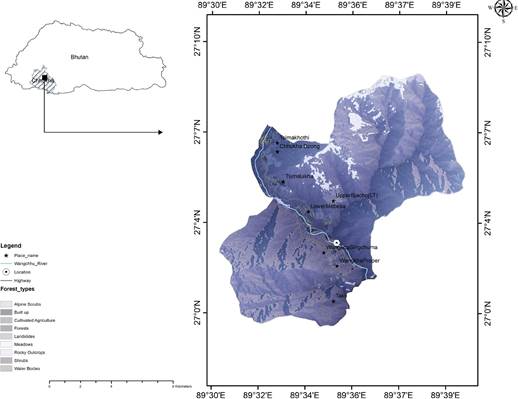Introduction
During an orchid inventory expedition to the southern part of Bhutan in May 2014 by a research team from the National Biodiversity Centre in Serbithang, Bhutan (NBC), plants of a Chiloschista Lindl. species without flowers were found growing epiphytically on small trees in deep shade near the Gelephu Tshachu, or hot springs, just north of the city of Gelephu in the Sarpang District and near the Assamese Indian border. A few plants were collected for cultivation at the Royal Botanical Garden in Serbithang, where one plant flowered in May the following year. The identity of this plant turned out to be unknown. After some research, it was concluded that it represented a new species described as Chiloschista gelephuensis C. Gyeltshen & Dalström (2019). The flowers are yellow with brown spots like many other members of this genus, but the internal structure of the lip is distinct from other similar-looking species. The internal morphology of the lip has also turned out to be a useful tool for distinguishing other similarly colored Chiloschista species in Bhutan and elsewhere (Fig. 1). That led to the identification of two additional undescribed and similarly colored Chiloschista species in Bhutan: C. densiflora Gyeltshen, C.Gyeltshen & Dalström, and C. himalaica Tobgay, C.Gyeltshen, Dalström (Gyeltshen et al. 2020).
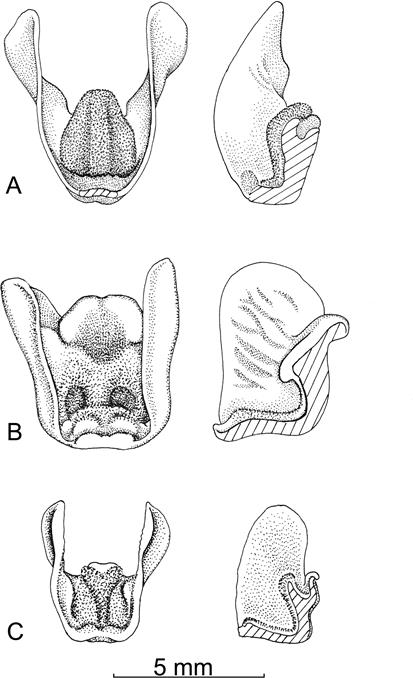
A. Chiloschista densiflora.
B. Chiloschista gelephuensis.
C. Chiloschista himalaica.
Drawings made from the type specimens by Stig Dalström.
Figure 1 The interior callus structures of the lip can be helpful in separating otherwise similarly looking Chiloschista species.
During the process of preparing the manuscript for the two latter Chiloschista species mentioned above, a third similarly colored taxon was discovered by Forest Ranger Bhakta Bdr. Ghalley, while on a leisurely stroll together with his wife and son along the Wangchhu river in the Chhukha district of Bhutan. Photos of this taxon were included in Gyeltshen et al. (2020), where it was speculated to be a potential new species. After revisiting the area in February and March of 2022, additional plant material was discovered and has been examined and preserved (Fig. 2). This led to the conclusion that it, indeed, is a new species and is described here. The much earlier February-March flowering season for the new taxon, compared to April-May for the sympatric C. himalaica, and the distantly distributed C. densiflora, and distinct differences in the internal lip morphology, together with the smaller flower with a relatively large anther cap readily separate this species from other spotted Chiloschista species in Bhutan and elsewhere (Fig. 3).
Taxonomic treatment
Chiloschista bhutanensis B.B.Ghalley & Dalström, sp. nov. Fig. 2, 3, 4.
TYPE: Bhutan. Chhukha: along Wangchhu river, epiphytic in warm broad-leaved forest, 27° 2’59.59''N; 89°34’52.43''E, alt. 1374 m, 27 Mar., 2022, B. Bdr. Ghalley s.n. (holotype: THIM).
Diagnosis: Chiloschista bhutanensis is most similar to the sympatric C. himalaica, but differs by an earlier flowering season, the paler and smaller flowers, ca. 10 mm across versus 12-13 mm across for the latter species. Chiloschista bhutanensis also differs from other similarly colored species in the genus by a distinct erect interior hump near the middle of the bottom of the lip, and by a distinctly larger anther cap in relation to the overall size of the flower.
Epiphytic herb. Roots numerous, spreading, terete to slightly flattened, 2-3 mm in diameter and ca. 24-30 cm long. Stem reduced, virtually absent. Leaves seasonal and only present during the rainy season, and not seen on flowering plants (the holotype). Inflorescence sub-erect to pendent, 1-10 cm long, but usually very short and densely flowered, almost straight to indistinctly flexuous, micro-pubescent, densely 4 to 13-flowered; peduncle 8-10 mm long; rachis 2-4 mm long; bracts scale-like, narrowly acute, 2-3 mm long. Pedicel with ovary micro-pubescent, 3-4 mm long. Flower pale yellowish to white with brown spots, and with rather flat and spreading sepals and petals; lip generally white with pale brownish bars inside the lateral lobes and occasionally with a pair of minute brown dots near the apex of the front lobe; dorsal sepal broadly obovate to sub-orbiculate, erect or bent forward over the column, mainly glabrous, ca. 6 × 3 mm; lateral sepals similar in shape, mainly glabrous, fused basally along the micro-pubescent column foot, ca. 6 × 4 mm; petals similar in shape, glabrous, sessile and fused to the micro-pubescent column foot, sub- rectangular to indistinctly obovate, apically rounded, ca. 5 × 3 mm; lip rigidly attached to the apex of the column foot, deeply saccate and indistinctly canaliculated ventrally, tri-lobed, lateral lobes erect to indistinctly curved inwards, apically rounded, front lobe short and erect, fleshy, indistinctly bi-lobed, lip in total ca. 4 mm high and 2-3 mm wide; callus of a fleshy basically glabrous to micro-pubescent swelling near the base, developing into a raised and distinct hump near the middle of the bottom of the sac-like lip, and with a tuft of glandular hairs near the base of the bi-lobed, erect but indistinct front lobe; column with the apical free part short and stocky, ca. 3.6 mm long, including the column foot; anther cap light yellow, galeate and minutely rostrate, ca. 1 mm across, with a pair of hair-like, easily broken off and partially missing on the type specimen, ca. 1 mm long tendrils on each side; pollinarium of 2 globose, cleft pollinia on a narrowly rectangular ca. 0.6 mm long stipe, on a sub-quadrate, indistinctly concave viscidium.
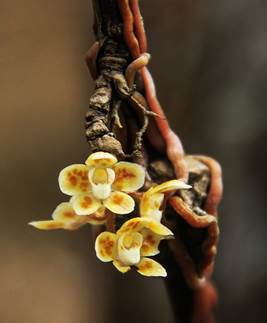
Photo by Bhakta Bdr. Ghalley.
Figure 2 A revisit in 2022 of the Wangchhu river location revealed more blooming plants of what has become Chiloschista bhutanensis.
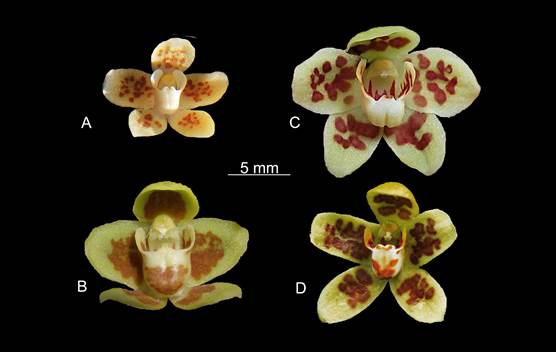
A. Chiloschista bhutanensis.
B. Chiloschista densiflora.
C. Chiloschista gelephuensis.
D. Chiloschista himalaica.
Photo arrangement by Stig Dalström.
Figure 3 The four spotted Chiloschista species known from Bhutan.
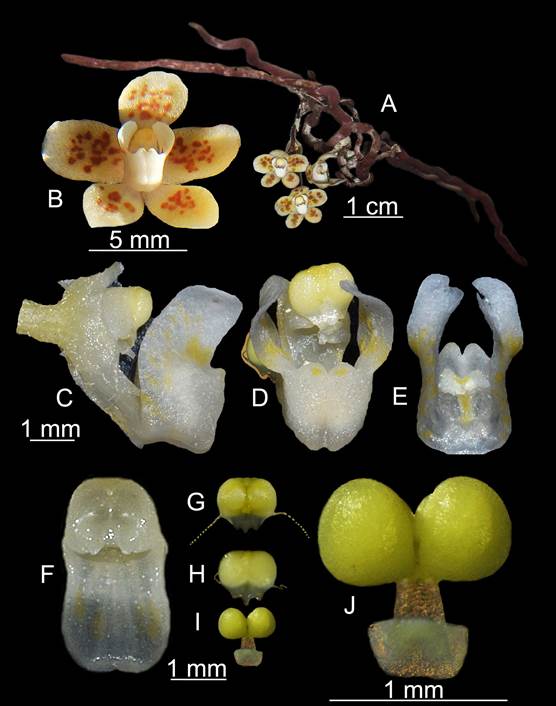
A. Plant habit.
B. Flower.
C. Column and lip, lateral view (from preserved material).
D. Column and lip, frontal view.
E. Lip, back and interior view.
F. Column, front view.
G. Anther cap, ventral view (tendrils partially missing).
H. Anther cap, dorsal view (tendrils partially missing).
I-J. Pollinarium. From B. Bdr. Ghalley s.n. (holotype: THIM).
Figure 4 Chiloschista bhutanensis B.B.Ghalley & Dalström.
Distribution: Chiloschista bhutanensis is only known from the original type locality along the Wangchhu river in the Chhukha district of southwestern Bhutan, growing epiphytically on rough-barked trees such as Alnus nepalensis D.Don (Betulaceae) and Albizia Durazz. sp. (Fabaceae).
Etymology: Named in reference to the country of origin to which this tiny but attractive species may very well be endemic.












 uBio
uBio 
